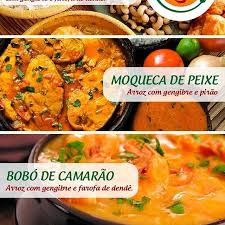Este post também está disponível em:
Português
English

Northeastern cuisine has been directly influenced by the socio-economic factors of the region.
The dishes have characteristics of Portuguese cuisine, known during the colonial period; African culture, absorbed at the time of slavery; and indigenous food, inherited from the native population.
The recipes generally include vegetables, beef and goat meat, fish and seafood. Due to the caatinga biome, the dishes have acquired a strong, spicy and high-calorie flavor.
On the coast, on the other hand, they have a strong flavor, as well as a variety of ingredients and colors.
The variety of biomes in the Northeast is reflected in the Northeastern cuisine.
On the table of the sertanejo, the semi-arid climate of the caatinga leaves its mark on dishes linked to food preservation and high calorie levels.
In the agreste and its extensive coastline, the recipes take on a diversity of ingredients and colors.
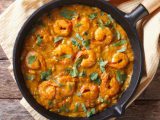
The strong flavor and taste for pepper, however, mark Northeastern cuisine as a whole.
Many of the dishes are found throughout the region, but visitors can find special ways of preparing them in each of the nine states.
The Northeast includes Bahia (BA), Sergipe (SE), Alagoas (AL), Pernambuco (PE), Paraíba (PB), Rio Grande do Norte (RN), Ceará (CE), Piauí (PI) and Maranhão (MA).
Multicultural Ingredients in Northeastern Cuisine
In addition to the native fruits of the caatinga and the agreste, Northeastern cuisine has included novelties brought by foreigners on its menu.
Coconut, an important ingredient in regional cuisine, was brought from India by the Portuguese.
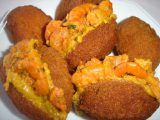
The sarapatel and buchada are dishes based on Portuguese cuisine.
In the Sertão, cowboys continue to eat simple, hardy dishes made with sun-dried meat, manioc, corn and beans.
Dendê oil, a spice found in many of the typical dishes, as well as chili peppers, were brought by the Africans.
Acarajé and vatapá are the fruit of this cultural mix.
It is a cuisine rich in spices and creativity. Get to know the main ingredients used in the region:
Fruits in Northeastern Cuisine
The immense variety of fruit consumed in the region is mainly used to make juices and sweets. Some of them are: guava, cashew, banana, mango, jackfruit, araçá, mangaba, sapoti, umbu, cajá and graviola.
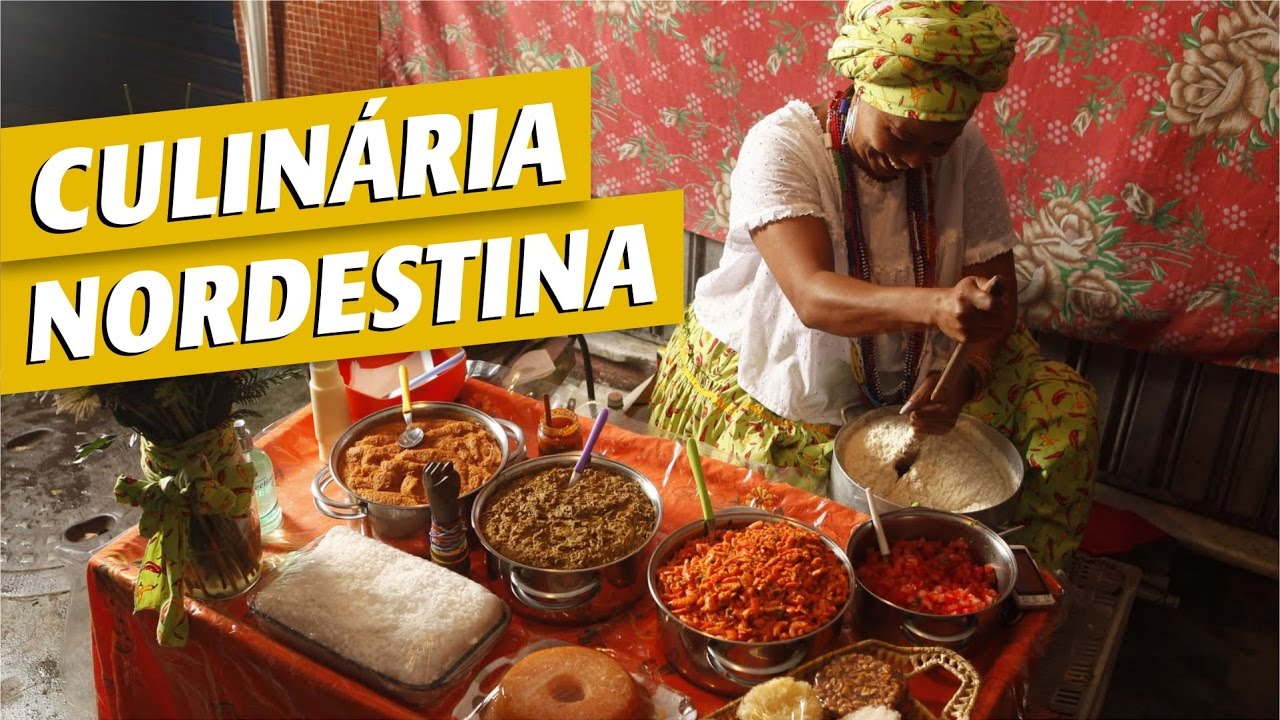
Cashew
Cashew nuts are also extracted and used in many traditional recipes.
Dendê oil
Mainly used in Bahia, palm oil has an orange color, which helps color dishes, and a unique taste. Produced widely in the southeast of Bahia, it is extracted from a palm tree that originated on the east coast of Africa.
Chilli pepper
Malagueta pepper was brought by blacks from Africa and is mainly used in Bahian cuisine.
Coconut milk
Coconut milk is made from the white flesh of the coconut, beaten with a little water and strained. It is used, for example, in shrimp bobó.
Fish and Seafood
The northeastern coast provides fish, molluscs and crustaceans that are widely used in local cuisine. Several dishes are based on large prawns. Crabs and crabs are served in portions.
Beans
There are several types. White, black, green and black-eyed peas are the most commonly used.
Coalho cheese
A typical product of the northeastern hinterland, it is handmade. It is found mainly in Pernambuco, Paraíba, Ceará and Rio Grande do Norte.
Corn
Corn is consumed in countless ways, not just in the Northeast. It can be boiled or roasted and serves as the basis for preparing canjicas, cakes, ice cream, pamonha, curau, among other recipes.
Mandioca
In the Northeast, the sweeter version of this root is known as macaxeira. The flour is used as an accompaniment to dishes and can even be eaten for breakfast.
Beef
It’s typical to find beef already dried in the sun (carne de sol) or air-dried and preserved with salt (carne seca). It can be served in portions or used as an ingredient in local dishes.
Northeastern cuisine for the June festivities
In the interior, one of the traditions is the festas juninas, which have contributed to the production of various dishes.
The festival, which pays homage to the Catholic saints St. Anthony, St. John and St. Peter, is the result of the union of Christian festivities with indigenous ones, forming something close to what happens today.
It is one of the most traditional events in the Northeast and takes place in all the states, which often compete for the title of the biggest celebration.
In addition to the dances, typical music and games, one of the biggest attractions is the typical sweets served.
The foods used in the festival are those grown by the indigenous people, such as manioc, corn and peanuts.
Typical Festa Junina dishes include pamonha, which, eaten sweet or savory, is made with grated corn and milk; canjica, made with corn, sugar, milk, condensed milk, coconut milk, grated coconut or peanuts; pé de moleque – a kind of cake made with cassava dough, chestnuts and a syrup made from sugar and butter; cocada, a sweet of Angolan origin made with coconut, condensed milk and coconut milk; and curau, a pasty sweet whose main ingredients are green corn cream, cow’s milk or coconut milk, sugar and cinnamon.
The Festa Junina is one of the most traditional events in the Northeast and takes place in all the states, which often compete for the title of the biggest celebration.
In addition to the dances, typical music and games, one of the biggest attractions is the typical food served at the party.
The main delicacies of Northeastern cuisine
Cooked corn
After removing the straw and hair, the corn is boiled and served with salt and, possibly, butter.
Canjica
Also known as curau in several states, it is a sweet made from crushed corn dough and coconut milk, served with powdered sugar and cinnamon.
Pé de moleque
This sweet is made in very different ways in each part of the country. One of the forms traditionally found at festivals, especially in Pernambuco, is a kind of cake made with cassava dough, chestnuts and a syrup made from sugar and butter.
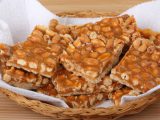
More to the south of the country, the sweet is made from rapadura and peanuts.
Cocada
Coconut candy made with white or dark sugar. It can be found being sold in the streets, like a tray sweet.
Rice pudding
Jam made with rice and milk. It can have condensed milk and be served with cloves and cinnamon.
Pamonha
Sweet or savory, pamonha is made with grated corn and milk.
Couscous
A dish of African origin, it has various recipes that can include cornflakes, sardines, egg and codfish sauce.
Typical dishes of Northeastern cuisine
Buchada
The recipe uses goat entrails cooked in the animal’s stomach (bucho). For strong stomachs.
Carne de sol com pirão de coalho
This is carne de sol served with a pirão made from coalho cheese, milk, bottle butter and manioc flour.
Baião de dois
A dish made with green or black-eyed beans, mixed with white rice, dried or sun-dried meat and curd cheese. Served with the typical bottle butter.
Dried meat casserole
Farofa made with manioc flour, ground dried meat and onion. It can be served with bananas and accompanied by baião de dois.
Tapioca
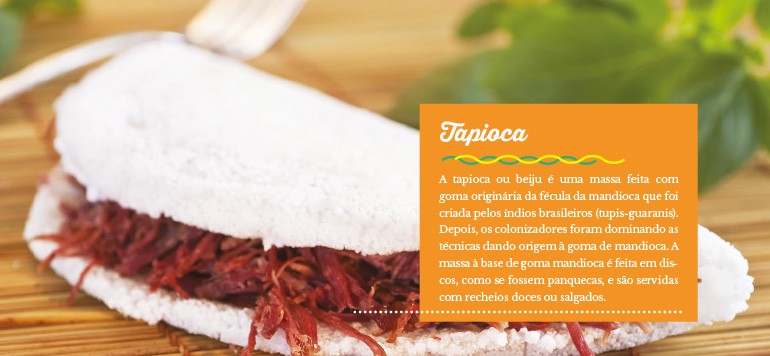
The cassava-based dough is made into disks, like pancakes, and is served with sweet or savory fillings.
Acarajé
Typically prepared by Bahian women, acarajé is a fried bean dumpling in palm oil. It can be filled with vatapá, caruru and chili sauce.
Moqueca
Fish stew with coconut milk, palm oil, pepper and coriander.
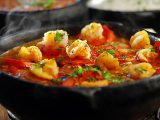
Caldo de sururu
Soup made with shellfish, coconut milk and palm oil.
Caldo de mocotó
the soup served hot is made with ox legs, from which the traditional broth comes.
Dobradinha
A dish based on white beans cooked with beef belly.
Sarapatel
With varied recipes in each state, sarapatel is a stew made with pork, lamb or goat entrails, thickened with the animal’s blood. It is served with flour and pepper.
Vatapá
There are several versions of shrimp cream, which can include bread, breadcrumbs or cornmeal, peanuts, cashew nuts, pepper, coconut milk and palm oil.
Caruru
Like vatapá, this dish has fallen in love with the people of Pará and is also served there, with a few modifications. Basically, caruru is a pirão (cassava flour mixed with a hot broth) made with okra, prawns, green seasoning and palm oil.
Bolo de rolo
The sweet is made with a thin sponge cake rolled up with layers of guava, covered in sugar. Served in thin slices.
See more in the menu above “Culture, History and Religion”
Characteristics, origin and main foods of Northeastern cuisine
Bahia.ws – Tourism and Travel Guide to Salvador, Bahia and the Northeast
